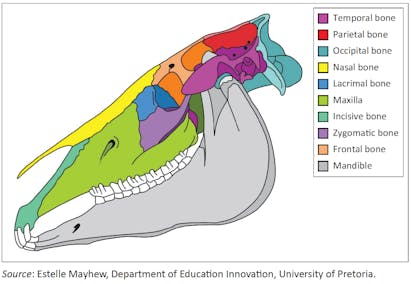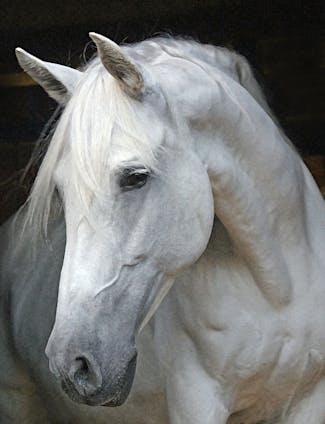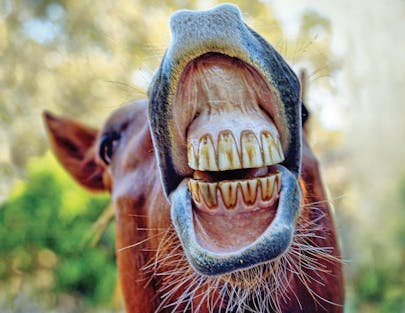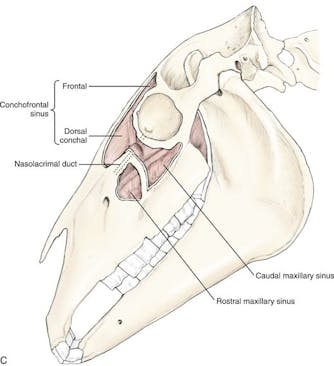The cranium of a horse, like that of other mammals, is the bony structure that forms the skull and encases and protects the brain. Here is some information about a horse's cranium:
what is the Structure?
The horse's cranium is composed of several bones that are tightly joined together to form a solid protective structure. These bones include the frontal bone, parietal bones, occipital bone, and temporal bones, among others.
how is the brain protected?
The primary function of the cranium is to protect the horse's brain from injury. The brain is a vital organ, and the cranium's sturdy structure helps safeguard it from external trauma.
Cranium Structure:
The horse's cranium is made up of strong, bony structures that encase the brain. These bones, including the frontal, parietal, occipital, and temporal bones, are sturdy and provide a solid shield around the brain.
Sutures:
The bones in the horse's cranium are connected by sutures, which are fibrous joints that allow for some flexibility. This flexibility is important because it allows the skull to absorb and distribute forces that may occur due to head trauma. It also permits some growth and expansion of the skull as the horse matures.
what is the average Size and Shape?
The size and shape of a horse's cranium can vary depending on the breed and individual horse. Generally, horse skulls are elongated and have a somewhat triangular shape when viewed from above. here are 2 that are commonly observed
Elongated Shape:
A horse's cranium typically has an elongated shape when viewed from the side. This elongation is particularly noticeable from the profile view of the head. The elongated shape helps accommodate the size of the horse's brain and provides protection.
Triangular Profile:
When viewed from above, the cranium of a horse often appears somewhat triangular. This triangular shape is a result of the combined shapes of the frontal, parietal, and occipital bones.
Sutures:
The bones in the horse's cranium are joined together by sutures, which are fibrous connections that allow some degree of flexibility. This flexibility is important for accommodating the changes in the brain's size and shape as the horse grows.
how do Nasal Passages help?
The cranium also houses the nasal passages, which are responsible for the horse's sense of smell and play a role in respiration. The shape and size of the nasal passages can vary between horse breeds.
Breathing:
Horses are obligate nasal breathers, meaning they primarily breathe through their noses rather than their mouths. This adaptation allows them to maintain a more consistent airflow and helps protect their respiratory system during strenuous activities.
Nasal Cavity:
The nasal cavity is a complex structure within the cranium responsible for filtering, humidifying, and conditioning the air as it enters the horse's respiratory system. It is located behind the horse's nostrils (external nares) and extends upward into the head.
Nasal Cavity:
The nasal cavity is a complex structure within the cranium responsible for filtering, humidifying, and conditioning the air as it enters the horse's respiratory system. It is located behind the horse's nostrils (external nares) and extends upward into the head.
Teeth...
The horse's cranium is also home to its teeth. Horses have a distinctive set of teeth, with both incisors and molars, that are adapted for grazing and grinding plant material.
Types of Teeth:
Horses have two types of teeth: incisors and cheek teeth. These different types of teeth serve distinct functions in the horse's chewing and grinding process.
Incisors:
These are the front teeth in a horse's mouth. Horses have a total of 12 incisors – six on the top and six on the bottom. Incisors are used for cutting and biting off grass and other vegetation. They play a crucial role in prehension, allowing the horse to grasp and tear grass or other forage.
Cheek Teeth:
Cheek teeth include premolars and molars. Horses typically have a total of 24 cheek teeth – six premolars and six molars on the top and bottom of each side of the mouth. Cheek teeth are responsible for grinding food into smaller particles for digestion. Unlike incisors, which have a single root, cheek teeth have multiple roots that anchor them securely in the horse's jaw.
Eye sockets...
The horse's cranium contains eye sockets (or orbits) that protect and house the horse's eyes. The positioning of the eyes on the sides of the head provides horses with a wide field of vision, helping them detect predators and obstacles in their environment.
Protection:
The primary function of the eye sockets is to protect the delicate structures of the eye, including the cornea, lens, and retina. The bony walls of the orbits serve as a barrier against external trauma and injury.
Vision:
Horses have excellent vision, both during the day and in low-light conditions. The size and positioning of the eyes in the eye sockets play a crucial role in their ability to see and perceive objects in their environment.
Foramen Magnum:
The foramen magnum is an opening at the base of the occipital bone in the cranium through which the spinal cord passes, connecting the brain to the spinal column.Evolutionary Adaptations:
Over millions of years, the horse's cranium has evolved to accommodate its herbivorous diet and grazing habits. The teeth and jaws have adapted to efficiently process plant material.
Research and Study...
The study of horse craniums and skulls is important in fields such as paleontology, veterinary medicine, and equine anatomy. Researchers use craniums and skulls to learn about the evolution, biology, and health of horses.
Understanding the anatomy of a horse's cranium is crucial for veterinarians, researchers, and anyone involved in horse care to diagnose and treat injuries, diseases, or other health issues that may affect this vital part of the horse's body.
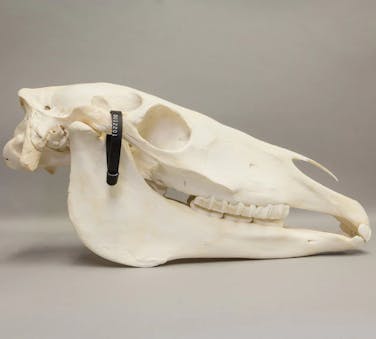
cranium info...
